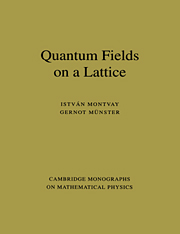5 - Quantum chromodynamics
Published online by Cambridge University Press: 22 September 2009
Summary
Quantum Chromodynamics (QCD) is believed by most physicists to be the correct theory of the strong nuclear force. Besides the qualitatively correct description of the hadron spectrum by bound states of light (u-, d- and s-) and heavy (c and b-) quarks, the main source of confidence is the successful application of quark–gluon perturbation theory to calculate the cross-sections of many short distance (large transverse momentum) processes (see, for instance, [A4]).
The outstanding property of QCD, which is the basis of the success of perturbation theory, is asymptotic freedom. According to it the effective quark–gluon and gluon–gluon couplings become small at short distances. This unique property is a consequence of the self-coupling of gluons, the quanta of the non-Abelian SU(3) colour gauge field. The counterpart of asymptotic freedom at high energies is infrared slavery at low energies, which is due to the increase of the effective coupling at ‘long’ distances (of the order 1 fermi). The consequence is the confinement of quarks and gluons inside colour singlet hadrons. The basic property of confinement and the approximate SU(3) ⊗ SU(3) flavour symmetry of light quarks qualitatively describes many features of the hadron spectrum and of other low energy strong interaction phenomena. But due to the strong couplings, a precise quantitative description of these phenomena is difficult. This spoils to some extent even the predictions of perturbative QCD, because the confinement acts also on the initial and final states of every short distance ‘hard’ process.
- Type
- Chapter
- Information
- Quantum Fields on a Lattice , pp. 231 - 317Publisher: Cambridge University PressPrint publication year: 1994

